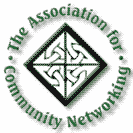
|
|
Democratic Vistas: Community Networking as the Practical Work of Regional and Local Organizing
 There are metaphors and frames without which we would be at a loss to convey the profundity of change in our conception of the world and our possible futures. Such archetypal ideas have been called conceptual primitives: they involve words that are overloaded with meaning and can’t be limited within particular definitional forms, finding application in diverse contexts and communities of discourse. Doubly so when we combine Community and Networking. The current invitation to practice community networking offers a timely return to the relevance of place alongside recent invitations centered on process. The achievements of RTPnet and TINCAN that Judy Hallman and Karen Michaelson write about in this issue clearly grow out of and contribute back into the life and culture of Raleigh-Durham, NC, and Spokane, Washington. In the United States, policy folk speak of the “States as Policy Laboratories” where policies can and should be field-tested and, hopefully, the successful models replicated elsewhere. The October Rural TeleCon (RTC) conference in Lexington, Kentucky emphasized this view with respect to U.S. broadband policy. Admittedly, our view of politics may have grown a little more cynical and polarized. Rather than policy laboratories, it is easy to see battlegrounds, especially as we gird ourselves for the reconsideration of national telecommunications and media policy soon to come before Congress. So do let us take advantage of the smaller arenas where it is easier to view politics as a grand experiment where we all play a significant part. Let the republic be a question, and let us take part in ensuring appropriate method and safeguards in answer to the pressing issues of the day with a commitment to the long view. We each have a role and stake in governance. In the Community Information and Communications Technology sector, we are uniquely positioned to promote an inclusive and extensive vision that is, at heart, political in the grand and experimental sense of civic engagement and that evokes those struggles that inspired the democratic vistas once painted on the world stage. In Illinois, we call for "Digital Literacy, Access, and Equity" as we create the Illinois Community Technology Coalition. We are experimenting with a model of “civic engagement and improving the quality of life by working together,” exploring how we can be of meaningful resource to each other in a network. We’ve been inspired by colleagues in Ohio, California and Minnesota, to name just a few. And like Ohio and elsewhere, we’ve placed community networking at the center of our effort to organize stakeholders around a bold vision. These regional developments are our field’s most vital response to the challenges of our day. Together we participate in a national—and moreover, worldwide—movement. Thankfully there are now networks of practice that connect us with national organizations promoting our philosophy. But the complex web of governance and jurisdiction involves local and state as well as national, and in some cases international, bodies. It turns out that these national organizations we have formed to serve our collective interests (AFCN, CTCNet, RTC, etc.) are greatly dependent upon strong regional capacity if they are to accomplish what we’ve asked of them. National level organizations frequently are organized around an issue or around a field of practice. There is nothing unusual in this. What is significant is that local and regional organizing is more effectively undertaken on another basis: the engagement of diverse stakeholders in the widest common frame, rather than a community of practice or vested interest in particular issues. In the last issue of the CTR, Angela Stuber, Executive Director of the Ohio Community Computing Network and President of the Board of CTCNet, described a shift in this direction for the Ohio model. The new mission statement extends beyond CTCs to community technology services and programs. Likewise, the "Digital Vision" proclaimed in Cleveland at the CTCNet national conference entails a process of engaging stakeholders in a meaningful way that crosses the categories that orient us within our field. In Illinois—in our expression of a grand and inclusive vision to bring together individuals and organizations concerned with promoting digital literacy, access and equity—we are actively reaching out to diverse communities of practice. We believe that community information and communications technologies have application in all spheres of our common life; they require and enable the opportunity to engage us all in civic life and processes of governance. The process of organizing on this regional basis is not easy. It is colored by the language and place from which one starts. How it unfolds where you undertake this effort will be shaped by local concerns and the stakeholders you can convene, and there is as much messiness as there is beauty in this very human interaction. Perhaps this meets Garth Graham's call to "Community Networking as Radical Practice" in the recent Journal of Community Informatics article where he otherwise questions our status as a movement. By shifting to a radical local-global practice in a process of continual organizing, we return to our roots. We can’t despair the death of community networking if this has been a shedding of surface features. If Garth is right, we’re much deeper than a movement. But this will take significant movement on our part, and not just a little storytelling. Tell your story in your community, involving all members in the process. As your stories unfold, share them with us. If our states and local communities are to be the locus of social experiment, with our field in a facilitating role, we need not do so in isolation nor in competition with each other—though a little local pride won’t hurt and may very well be necessary. Common Disaster—and Opportunity
Community networking offers a profoundly new way of looking at the world, its forms and language still unfolding. We’re only just catching up with the dynamic nature of the world and the potential for diversity in social organization and yet we’re equally prone to abandon our progress for a false sense of security. The Gulf storms of 2005 made the case for distributed capacity and expertise to deploy networks throughout society—in business and government as well as community. Mobilization for everything needed, from direct help to communications network deployment to database development and support, presents a challenge. We have the opportunity to redefine "critical infrastructure" to include human systems and coordination of volunteer resources and talents. There are numerous stories of responses to these natural disasters that are cases in point. In this CTR issue, several authors share these stories: Matt Walker on CTC efforts, Gene Crick on TeleCommunity.US crisis management in Austin, Nichole Payne's account of Tech for All's building the Astrodome Community Technology center in Houston, and Nicole Friedman on Chicago's Center for Neighborhood Technology Wireless Community Network's volunteer efforts in Louisiana highlight some exemplary work in this regard.  Michael Maranda is the President of the Association For Community Networking and Director of CTCNet Chicago as well as Co-Chair of the Illinois Community Technology Coalition.
Hyperlinks references in this article: Comments
|